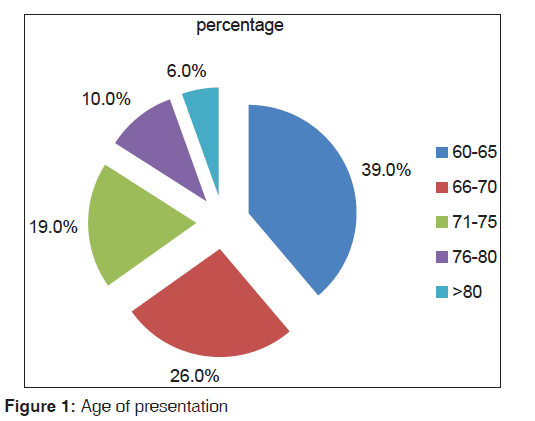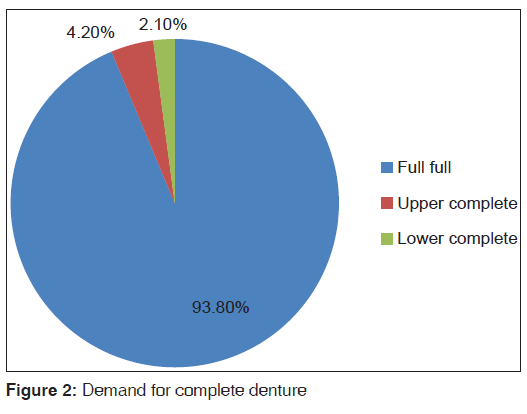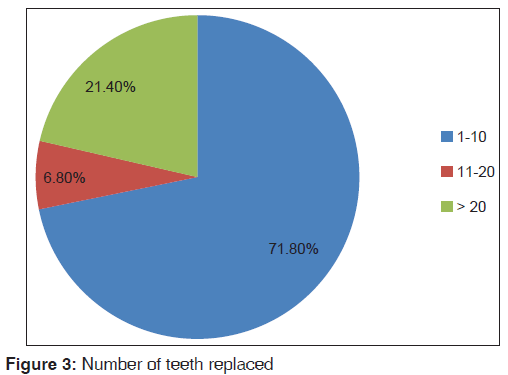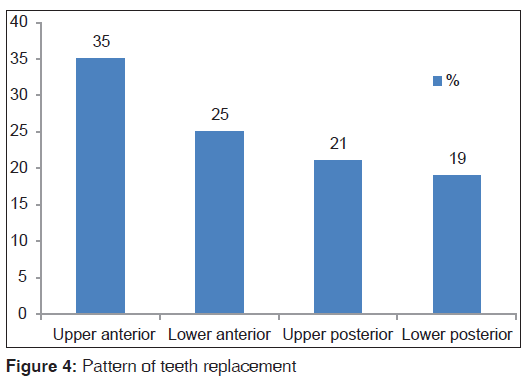Utilization of Teeth Replacement Service Among the Elderly Attending Teaching Hospitals in Lagos, Nigeria
- *Corresponding Author:
- Dr. Bolanle Oyeyemi Akinboboye
Department of Restorative Dentistry, College of Medicine University of Lagos, Lagos University Teaching Hospital, Idi Araba Lagos.
E-mail: bolanleyemakins@yahoo.com
Citation: Akinboboye BO, Akeredolu PA, Sofola O, Ogunrinde BO, Oremosu OA. Utilization of teeth replacement service among the elderly attending teaching hospitals in Lagos, Nigeria. Ann Med Health Sci Res 2014;4:57-60.
Abstract
Background: Tooth replacement service is generally available in our environment. However, its utilization by the elderly has not been extensively studied. Aim: To determine the utilization of tooth replacement services among the elderly. Materials and Methods: This was a retrospective study of 440 patients aged 60 years and above attending the prosthetic out‑patient clinics of Lagos University teaching hospital (LUTH) and Lagos state University teaching hospital (LASUTH) from January, 2008 to March, 2010. record books or case records: Age, sex, and number of teeth replaced. Results were collated and analyzed using Epi Info 2004. Values were presented as simple percentages. Results: There were 229/440 (52.0%) males and 211/440 (48.0%) females and were aged 60‑90 years with a mean age of 68.9 (6.92). A total number of 4,062 teeth were replaced. Average number of tooth replaced among the patients was 9.45 for LUTH and 8.94 for LASUTH. The maxillary anterior teeth were the most frequently replaced 1422/4062 (35.0%) and the least replaced were the mandibular posterior teeth 812/4062 (20.0%). The average number of tooth replaced generally increased with age in both sexes. A total of 90 complete maxillary and mandibular dentures were fabricated, while six single arch complete dentures were made. The remaining were partial dentures. Conclusion: The most common age of presentation is 60‑65 years. Patients that were 90 years and above appear to utilize teeth replacement facilities in this environment less than those in developed countries. Maxillary anterior teeth were the most frequently replaced.
Keywords
Elderly, Tooth replacement, Type of prosthesis/dentures
Introduction
Teeth play an important role in the maintenance of a positive self-image.[1] Replacement of lost teeth has been documented to be the most common reason for attendance in the prosthetic out-patient clinic of Lagos university teaching hospital (LUTH).[2,3] The adverse effect of tooth loss without replacement includes, drifting and tilting of adjacent teeth, rotation of teeth, over eruption, loss of contact area with formation of food traps. Others are faulty speech, changes in appearance and adverse psychological changes.[4]
The loss of teeth can be very traumatic and upsetting and could be regarded as a serious life event that requires social and psychological readjustment.[5,6] In most developed countries, the accepted chronological age of the elderly people is 65 years, as a definition of the United Nations standard numerical criterion of 60 + years.[7] The elderly are therefore more prone to tooth loss since the likelihood of tooth loss increases with age as a result of the cumulative effects of caries, periodontal disease, trauma and dental treatment. It has also been noted that elderly people with poor oral health status leading to edentulousness, have problems with social situations and interpersonal contacts, which can lead to depression and affect their general well-being.[8] The negative impact of poor oral conditions on daily life is particularly significant among the elderly edentulous people. A study done among community-dwelling elderly people aged 70-75 years in Italy noted that there was a close relationship between dental status and nutrient in take.[9]
Periodontal disease is a major cause of tooth loss in the elderly in Nigeria.[10] Macgregor[11] noted that the degree and pattern of permanent tooth loss in Nigerians was markedly different from the developed countries. He stated that tooth mortality in Nigeria was found to be very much less than in England and that early loss of incisor teeth was common amongst Nigerians, which may be probably due to periodontal disease.
The main purpose of replacement of missing teeth is to restore or improve appearance, ability to masticate, improve speech and to maintain the oral tissues in a healthy condition.[12] Teeth replacement options in Nigeria include over dentures, removable acrylic based dentures, implants and teeth supported (fixed) prosthesis. Fixed prostheses, though excellent options are quite expensive and may not be affordable options for most Nigerians.[12]
In a study done among older adult living in Japan, the percentage of utilization of tooth replacement services was stated to be 68.2%.[12] Bassey[13] in a study on oral health needs, among geriatric patient in a tertiary hospital in Nigeria reported the utilization of tooth replacement services as 29.6%. However, this study was conducted in one tertiary hospital more than two decades ago, and only for a year. Akeredolu[14] in 2004 did a study in LUTH on anterior teeth replacement and noted an increase in tooth replacement among the elderly. The evident socio-economic and demographic changes noted in Nigeria since the time of theses studies necessitated the need for a recent study. Therefore, this study was done to determine the pattern of replacement.
Materials and Methods
This was a retrospective study of 440 patients aged 60 years and above attending the prosthetic out-patient clinics of LUTH and Lagos State University Teaching Hospital (LASUTH) from January, 2008 to March, 2010. The following information was retrieved from the patient’s daily record books or case records: Age, sex, and number of teeth replaced. Results were collated and analyzed using Epi Info Version 3.5.1 (CDC, Atlanta, Georgia, USA). Values were presented as simple percentages.
Results
In the daily record books, 440 cases of elderly patients were found during this period. All the cases were used with no exclusion. The average age was 68.9 (6.9) years. The most common age of attendance was 60-65 years [Table 1]. The least common age of attendance was 90 years and above [Figure 1]. Table 2 shows the number of tooth replaced by gender and age. The average number of tooth replaced was more in males (9.6) than in females (8.7).
| Age (years) | LUTH n (%) | LASUTH n (%) | Total N (%) | ||||
|---|---|---|---|---|---|---|---|
| 60-65 | 108 (24.6) | 63 | (14.3) | 116 | (38.9) | ||
| 66-70 | 78 | (17.8) | 38 | (8.6) | 116 | (26.4) | |
| 71-75 | 53 | (12.1) | 30 | (6.8) | 83 | (26.4) | |
| 76-80 | 25 (5.7) | 21 | (4.8) | 46 | (10.5) | ||
| 81-85 | 9 | (2.1) | 8 | (1.8) | 17 | (3.9) | |
| 86-90 | 3 | (0.6) | 2 | (0.5) | 5 | (1.1) | |
| >90 | 2 | (0.5) | 0 | (0.0) | 2 | (0.5) | |
| Total | 278 (63.2) | 162 | (36.8) | 440 (100) | |||
| Mean age: 68.9 | (Standard deviation: 6.9) | ||||||
Table 1: Age distribution of participants
| Age range | Male | Female | ||||
| Frequency | NTR | AV.TR | Frequency | NTR | AV.TR | |
| 60-65 | 77 | 576 | 7.48 | 94 | 697 | 7.41 |
| 66-70 | 63 | 571 | 9.06 | 53 | 419 | 7.91 |
| 71-75 | 46 | 529 | 11.50 | 37 | 381 | 10.30 |
| 76-80 | 30 | 335 | 11.17 | 16 | 186 | 11.63 |
| 81-85 | 7 | 96 | 13.71 | 10 | 135 | 13.5 |
| 86-90 | 5 | 92 | 18.40 | 0 | 0 | 0.00 |
| >90 | 1 | 17 | 17.00 | 1 | 28 | 28.00 |
| Total | 229 | 2216 | 9.68 | 211 | 1846 | 8.75 |
Table 2: Teeth replacement in relation to age and sex
A total of 90 complete maxillary and mandibular dentures were fabricated, while 6 single arch complete dentures were made [Table 3]. The least treatment to be requested was for lower complete dentures [Figure 2].
| Complete denture | LUTH n (%) | LASUTH n (%) | Total n (%) |
|---|---|---|---|
| Complete upperand lower | 55(57.2) | 35 (36.5) | 90 (93.7) |
| Upper complete | 3(3.2) | 1 (1.0) | 4 (4.2) |
| Lower complete | 2(2.1) | 0 (0.0) | 2 (2.1) |
| Total | 96 (100.0) |
Table 3: Replacement with complete denture
Majority 2917/4062 (71.8%) [Figure 3] of patients replaced 1-10 teeth [Table 4] out of which the upper anterior 1422/4062 (35%) were the most replaced [Figure 4]. The least replaced teeth was the mandibular posterior teeth 812/4062 (20%) [Table 5].
| Number ofteeth replaced | LUTH n (%) | LASUTH n (%) | Total n (%) | |||
|---|---|---|---|---|---|---|
| 1-10 | 1659 | (40.8) | 1258 (31) | 2917 | (71.8) | |
| 11-20 | 179 | (4.4) | 97 (2.4) | 276 | (6.8) | |
| >20 | 544 (13.4) | 325 | (8.0) | 869 (21.4) | ||
| Total | 2382 | (58.6) | 1680 | (41.4) | 4062 (100.0) | |
Table 4: Number of teeth replacement
| Segment | LUTH n (%) | LASUTH n (%) | Total n (%) | |
|---|---|---|---|---|
| Upper anterior | 778 (19.2) | 644 (15.8) | 1422 (35) | |
| Upper posterior | 533 (13.1) | 320(7.9) | 853 | (21) |
| Lower anterior | 605 (15.0) | 370(9.1) | 975 | (24) |
| Lower posterior | 466 (11.5) | 346(8.5) | 812 | (20) |
| Total | 2382 (58.6) | 1680(41.4) | 4062 | (100) |
Table 5: Pattern of tooth replacement
Table 6 shows the number of patients seen between year 2008 and 2010 in the two institutions and also the average number of tooth replaced in the patients. The average number of tooth replaced among the patients was 9.45 for LUTH and 8.94 for LASUTH.
| Year | LASUTH | LUTH | TOTAL | |||||
|---|---|---|---|---|---|---|---|---|
| N | NTR | AV.TR | Frequency | NTR | AV.TR | Frequency | NTR | |
| 2008 | 68 | 660 | 9.71 | 97 | 857 | 8.84 | 165 | 1517 |
| 2009 | 86 | 716 | 8.33 | 115 | 1081 | 9.4 | 201 | 1797 |
| 2010 | 34 | 304 | 8.94 | 40 | 444 | 11.1 | 74 | 748 |
| Total | 188 | 1680 | 8.94 | 252 | 2382 | 9.45 | 266 | 4062 |
Table 6: Average teeth replaced yearly
Discussion
In this study, the average age of presentation in both centers was between 68 and 69 years. The mean age was slightly higher than similar study carried out in Japan where the mean age was 66.5 years.[12] This Japan study did not represent all the population of the elderly in Japan as well as this study, which is not representing all the elderly in Nigeria. It might therefore be that patients in their 60’s and above are aware of the availability of prosthetic services and are using such services.
In this study, the average tooth loss was higher in males than females. A similar finding to our study was reported by Akeredolu et al.[14] The reason for this was that males were more prone to tooth trauma especially, in their earlier year. In the study carried out in Japan,[12] more males utilized tooth replacement facilities more than females. The reason for this was that males had more time after retirement to take care of their dental health, which had been neglected in earlier years when they worked long hours. It might be that the reason for our result may be due to the fact that responses to dental problems in males are delayed compared to females resulting in higher tooth loss, which invariably leads to more demand for replacement. It might also be as a result of accumulated adverse effect of tooth trauma such as that acquired in contact sports which is more common in males. This invariably has a positive effect on tooth replacement although, this might also be influenced by factors such as lack of finance, poor health, availability of prosthetic services, + and patients’ awareness.
In this study, the average number of tooth replaced increased with age in both sexes. This is likely due to increase in tooth loss, which is as a result of cumulative effects of caries, periodontal disease, trauma, and dental treatment as age increases. In a study done by Idowu and Al-Shamrani[15] they reported similar finding of a steady increase in tooth loss with increase in age and this invariably leads to increase demand for replacement. In the study done by Akeredolu et al.[14] they noted a progressive increase in number of anterior tooth replaced with increase in age. Although, their study was done basically on anterior tooth replacement it is important to note that the highest number of teeth replaced in this population were that of anterior teeth. This is further corroborated with previous findings by Olushile and Esan.[16] Therefore, it can be that since the main reason for anterior teeth replacement is aesthetics, patients are becoming more concerned with their appearance even in the elderly. Studies have shown that aesthetics is one of the most important motivating factors for tooth replacement.[16,17] These studies observed that aesthetics might be the most important reason for demanding for removable prosthesis. It can therefore be that aesthetics is a major motivational factor to tooth replacement even in the elderly.
In this study, there was a gradual increase in teeth replaced from 2008 to 2009. In Bassey’s[13] study, done 25 years ago the utilization of prosthetic service was 29.6%. There seem to be an increase in the utilization of teeth replacement. This might be due to an increase in awareness of patients or an improvement in prosthetic facilities. In view of this it could be that there is an increase in awareness of prosthetic rehabilitation leading to increase utilization of prosthetic services.
Conclusion
The utilization of teeth replacement services was common between the age of 60 and 65 years. Aesthetics was found to be the major motivational factor for tooth replacement in the elderly.
References
- Roessler DM. Complete denture success for patients and dentists. Int Dent J 2003;53:340-5.
- Bassey IE. The prosthetic requirements of partially edentulous patients as seen in Lagos university teaching hospital. Nig Q J Hosp Med 1985;3:49-51.
- Bassey IE. Pattern of tooth choice of denture teeth in the Lagos university teaching hospital. Nig Q J Hosp Med 1996;6:67-71.
- Zarb GA, Mackay HF. The partially edentulous patient. II. A rationale for treatment. Aust Dent J 1980;25:152-162.
- Omar R, Tashkandi E, Abduljabbar T, Abdullah MA, Akeel RF. Sentiments expressed in relation to tooth loss: A qualitative study among edentulous Saudis. Int J Prosthodont 2003;16:515-20.
- Fiske J, Davis DM, Frances C, Gelbier S. The emotional effects of tooth loss in edentulous people. Br Dent J 1998;184:90-93.
- WHO health statistics and health information system.Definition of an older or elderly person. Available from: http://www.who.int/healthinfo/survey/ageingdefnolder/ en/idex.html. [Last accessed 2011 Jul 19].
- Avcu N, Ozbek M, Kurtoglu D, Kurtoglu E, Kansu O,Kansu H. Oral findings and health status among hospitalized patients with physical disabilities, aged 60 or above. Arch Gerontol Geriatr 2005;41:69-79.
- Appollonio I, Carabellese C, Frattola A, Trabucchi M. Influence of dental status on dietary intake and survival in community-dwelling elderly subjects. Age Ageing 1997; 26:445-456.
- Sheiham A. The prevalence and severity of periodontal disease in rural Nigerians. Dent Pract Dent Rec 1966;17:51-55.
- Macgregor ID. The pattern of tooth loss in a selected population of Nigerians. Arch Oral Biol 1972;17:1573-82.
- Ikebe K, Nokubi T, Ettinger RL. Utilization of dental health services by community-dwelling older adults in Japan who attended a weekly educational programme. Gerodontology 2002;19:115-122.
- Bassey I. The Oral health needs of geriatric patients as seen in Lagos University Teaching Hospital. Nig Dent J 1987;8:15-22.
- Akeredolu P, Omitola O, Savage K. Age, gender and pattern of tooth replacement at Lagos University Teaching Hospital. Nig Q J Hosp Med 2004;14:45-48.
- Idowu A, Al-Shamrani S. Pattern of tooth loss in a selected population at King Saud University College of Dentistry. Saud Dent J 1995;7:135-140.
- Olushile A, Esan T. Pattern of demand and removable partial dentures in Ile-Ife. Nig J H Sc 2002;2:6-8.
- Osterberg T, Hedegård B, Säter G. Variation in dental health in 70-year old men and women in Göteborg, Sweden. A cross-sectional epidemiological study including longitudinal and cohort effects. Swed Dent J 1984;8:29-48.








 The Annals of Medical and Health Sciences Research is a monthly multidisciplinary medical journal.
The Annals of Medical and Health Sciences Research is a monthly multidisciplinary medical journal.